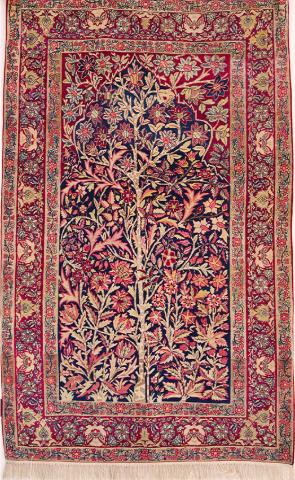The world's fascination with Persian carpets existed long before we heard tales of Aladdin and his Magic Carpet. A thousand stories of its weavers, their craftsmanship, and a promise to transport you to faraway lands stitch together the fabric of the quintessential Persian carpet. The history of its artistic magnificence dates back to 500 BC.
The Iranians were among the pioneer carpet weavers with the skill of carpet weaving handed down like a closely guarded family secret.
A Persian rug lasts a lifetime, but it’s not just a piece to cover the floor; it’s a work of art. [1]
The carpet is a weaver's canvas. Just like an artist who displays his/her moods in a painting. However, these carpets were once simple articles of need. A cloth to cover the floor with and protect people from the cold and damp. Soon enough, the growing beauty of these carpets struck the fancy of kings and noblemen. They saw them as symbols of prestige, royalty, and distinction. Glorious carpets soon adorned palaces and places of social gatherings.
Weavers are known to spend hours hunched over a loom creating thousands of knots, just like they did on this particular Persian Tribal Afshar Carpet below. This striking piece was carefully handwoven in Persia around the 20th century. Vibrant red drapes this hand-knotted carpet in royalty, while intricate geometric patterns align themselves around each medallion.
.jpg)
Persian Tribal Afshar Carpet, circa 1920
These carpets often represent a universal concept, revealing the outlook of the weaver at that time. Look at the Laver Kerman Carpet below, which is very rightfully titled the Tree of Life. The central medallion seems to grow into a glorious tree, branched out into subtle shades of red, rose, and green. Its descriptive beauty makes it a magnificent centerpiece for any room.

Tree of Life, circa 1920
Creativity flows everywhere, even from behind bars. Look at this Agra Jail Carpet handwoven by prisoners in Agra under the supervision of some of Persia's finest carpet weavers. Many such carpets were elaborately designed for Indian palaces. A lot of these carpets displayed original Indian patterns before the arrival of the Mughal reign.
.jpg)
Agra Jail Carpet, Hand-knotted - Vegetable / Natural dyes
Certain Persian carpets remind you of springtime. Such as this Kerman Carpet titled Millefleurs. Rich figural and floral designs suggest the arrival of spring. Laden with floral elements on a mustard-colored field, the carpet almost looks sunkissed. Elaborate patterns seem to be dancing all over this luxurious carpet like playful children wandering underneath the watchful rays of the sun.
.jpg)
Millefleurs, circa 1920
Some Persian carpets represent simplicity at its finest. Like this early nineteenth century Khotan Samarkand Carpet with intricate geometric patterns in harmony on an oasis of red. This oriental antique carpet makes a strong statement with the use of bold colors, an eye-catching central medallion, and geometric motifs.
.jpg)
Khotan Samarkand Carpet, circa 1930
A Persian carpet along with its exquisite charm also stands the test of time. It promises you eternal warmth, comfort, and luxury. It is indeed a visual treat with twirling patterns, bold colors, and elaborate designs. A Persian carpet is not just functional decor but a piece of art that is open to interpretation. It is no surprise that these carpets are often hung on walls like paintings, attracting the admiration of many.
References
[1] "The Quest for a Perfect Persian Rug", Fareed Sahloul, The Wall Street Journal, December 2014